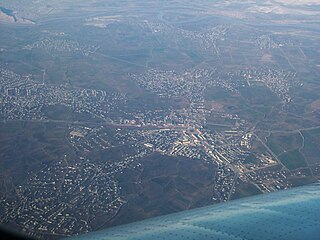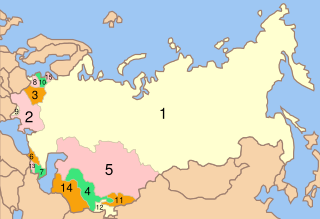
The 1959 Soviet census conducted in January 1959 was the first post-World War II census held in the Soviet Union. [1]

The 1959 Soviet census conducted in January 1959 was the first post-World War II census held in the Soviet Union. [1]
For a decade after World War II, there were no new population statistics released by the Soviet Union, [2] and a proposal for a new Soviet census for 1949 was rejected by Soviet leader Joseph Stalin. [3] During this time, most Western experts estimated that the population of the Soviet Union was between 215 and 220 million people, but in June 1956 (after Stalin's death), the Soviet government announced that the country's population at that point was only 200,200,000. [2]
The new census announced the Soviet Union's population to be 208,826,650, [4] an increase of almost forty million from the results of the last (disputed) census from 1939. [5] A majority of this population increase was due to the Soviet territorial expansion of the 1939–1945 time period, rather than due to natural population growth. [6] The deficit of men to women in the total Soviet population massively increased between 1939 and 1959, in large part due to World War II. [6] The Soviet Union acquired some additional territories (after its 1939 census) in 1939–1945 in what is now Ukraine, Belarus, Moldova, the Baltic republics, Karelia, Tuva, and Kaliningrad Oblast. The Soviet Union was just 33% urban in 1939, but urbanized rapidly to become almost half (48%) urban in 1959. [7]
The 1959 Soviet Union census reported populations in 126 nationality (ethnic group) categories, in comparison to only 97 categories in the 1939 census. [8] [9] Ethnic Russians still made up a majority of the Soviet population in 1959, [4] but their percentage was smaller than in 1939 (again, partly due to the acquisition of mainly non-Russian territories in 1939–1945). [5] Despite the acquisition of additional territories between these censuses, the Soviet Jewish population in 1959 (almost 2.3 million) was only about 75% of what it was in 1939, at least in large part due to the Holocaust. [4] [5] [10] The populations of the Baltic Soviet Socialist Republics (which were heavily affected by World War II) did not change much between 1939 [11] and 1959, with Lithuania actually experiencing a population decline during this time period. [6] During the same time, the population of the Russian SFSR (which was heavily affected by World War II) increased by less than ten percent. [6] The population increase in Ukraine and Byelorussia between 1939 and 1959 was completely or almost completely due to the Soviet territorial expansions of 1939–1940. [6] Without these territorial expansions, Ukraine's population would have only barely increased and Belarus's population would have actually decreased between 1939 and 1959. [6] The Central Asian and Caucasian Soviet Socialist Republics experienced large population increases between 1939 and 1959 despite the fact that they did not acquire any new territories during this time period. [6]
This census is also noteworthy as being the first census to classify Brest Region population as Byelorussians.


Demographic features of the population of Uzbekistan include population growth, population density, ethnicity, education level, health, economic status, religious affiliations, and other aspects of the population. The nationality of a person from Uzbekistan is Uzbekistani, while the ethnic Uzbek majority call themselves Uzbeks. Much of the data is estimated because the last census was carried out in Soviet times in 1989.

According to data from the 1989 Soviet census, the population of the USSR was made up of 70% East Slavs, 17% Turkic peoples, and less than 2% other ethnic groups. Alongside the atheist majority of 60%, there were sizable minorities of Russian Orthodox Christians and Muslims.

The history of the Jews in Armenia is one of the Jewish communities in the Caucasus region. There is evidence of Jewish settlement in the Armenian Highlands dating as early 1st century BC.

The Lom people, also known by non-Loms as Bosha or Posha or as Armenian Romani or Caucasian Romani, are an ethnic group originating from the Indian subcontinent. Their Lomavren language is a mixed language, combining an Indo-Aryan substrate with Armenian.

Sharur is a city in the Nakhchivan Autonomous Republic of Azerbaijan. It is the administrative centre of the Sharur District. The city is located 66 km northwest of Nakhchivan city, on the Sharur plain.
The following is a summary of censuses carried out in the Soviet Union:

The Black Sea Governorate was a province (guberniya) of the Caucasus Viceroyalty of the Russian Empire, established in 1896 on the territory of the Black Sea Okrug of the Kuban Oblast. The administrative center of the governorate was the Black Sea port of Novorossiysk. In 1905, the population of the governorate was approximately 70,000 and its area was 6,455 square versts, making it the smallest Russian governorate by both measures. The governorate ceased to exist when the Black Sea Soviet Republic was established on its territory in the spring of 1918—later the governorate was incorporated into the Kuban-Black Sea Oblast of the Russian SFSR in March 1920.

Preobrazheniye is an urban locality in Lazovsky District of Primorsky Krai, Russia, located on the Preobrazheniye Bay of the Sea of Japan. Population: 7,184 (2010 Census); 9,335 (2002 Census); 12,213 (1989 Census).
Moscow is the most populous city in Europe and Russia, population of which is mostly made up of ethnic Russians, but it also hosts a significant population of ethnic minorities. The last census of 2021 reported 69.7% of the population was Russian.

The Soviet census conducted in January 1970 was the first census held in Soviet Union (USSR) in eleven years.
Borisovsky Uyezd was one of the uyezds of Minsk Governorate and the Governorate-General of Minsk of the Russian Empire and then of Byelorussian Soviet Socialist Republic with its seat in Borisov from 1793 until its formal abolition in 1924 by Soviet authorities.
Minsky Uyezd was one of the uyezds of Minsk Governorate and the Governorate-General of Minsk of the Russian Empire and then of Byelorussian Soviet Socialist Republic with its seat in Minsk from 1793 until its formal abolition in 1924 by Soviet authorities.
Mozyrsky Uyezd was one of the uyezds of Minsk Governorate and the Governorate-General of Minsk of the Russian Empire and then of Byelorussian Soviet Socialist Republic with its seat in Mozyr from 1793 until its formal abolition in 1924 by Soviet authorities.
Pinsky Uyezd was one of the counties of Minsk Governorate and the Governorate-General of Minsk of the Russian Empire and then of Byelorussian Soviet Socialist Republic with its center in Pinsk from 1793 until its formal abolition in 1924 by Soviet authorities.
Rechitsky Uyezd was one of the Uyezds of Minsk Governorate and the Governorate-General of Minsk of the Russian Empire and then of Byelorussian Soviet Socialist Republic with its center in Rechytsa from 1793 until its formal abolition in 1924 by Soviet authorities.
Slutsky Uyezd was one of the uyezds of Minsk Governorate and the Governorate-General of Minsk of the Russian Empire and then of Byelorussian Soviet Socialist Republic with its center in Slutsk from 1793 until its formal abolition in 1924 by Soviet authorities.

In January 1979, the Soviet Union conducted its first census in nine years. Between 1970 and 1979, the total Soviet population increased from 241,720,134 to 262,084,654, an increase of 8.4%.
The census in Azerbaijan is a process of collecting, summarizing, analyzing and publishing the demographic, economic and social data of the population living in the territory of Azerbaijan. The next census in the Republic is expected to be held in 2029.

The Noyemberyan District was a raion (district) of the Armenian Soviet Socialist Republic from 1937 to 1991 and of the Republic of Armenia from 1991 to 1995. It now constitutes the northeastern part of the Tavush Province (marz) of Armenia. Its administrative center was the town of the same name.